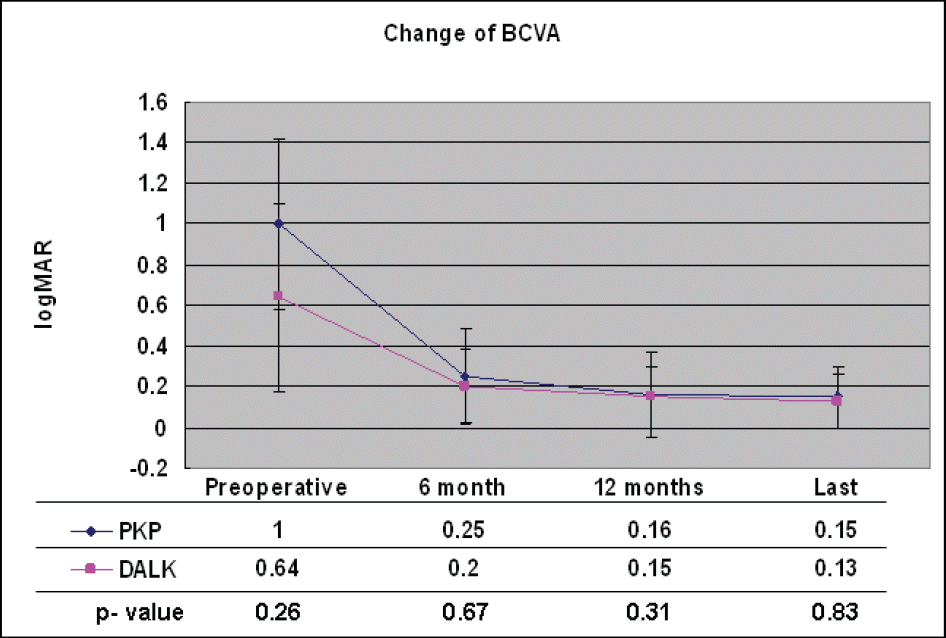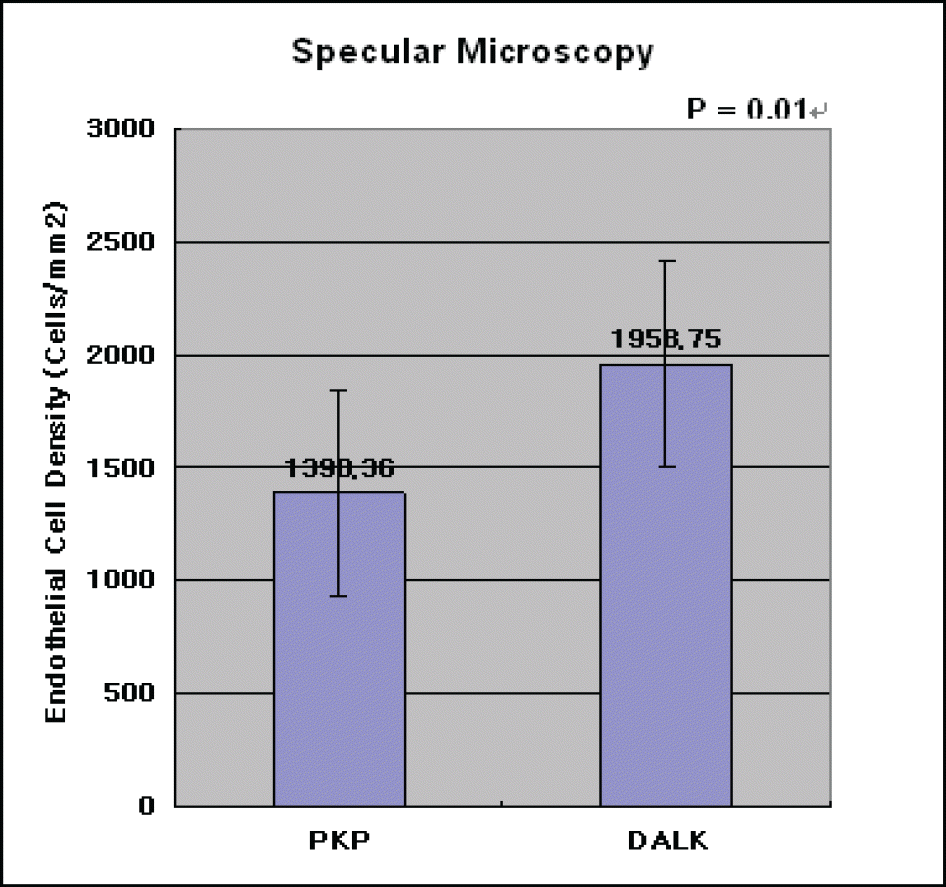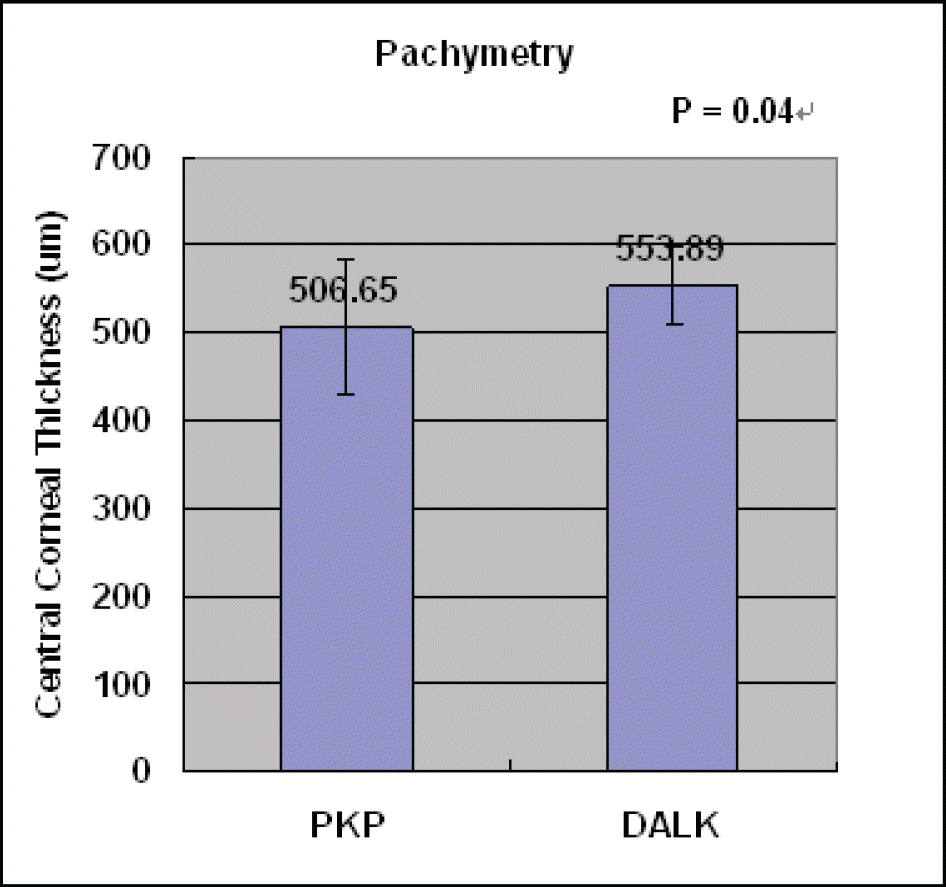Abstract
Purpose
To compare the therapeutic outcomes after deep anterior lamellar keratoplasty (DALK) and penetrating keratoplasty (PKP) in patients with keratoconus.
Methods
We retrospectively reviewed the clinical records of 57 patients diagnosed with keratoconus who had undergone DALK (19 eyes of 19 patients) and PKP (38 eyes of 38 patients) in Samsung medical center between January 1995 and January 2006.
Results
The 19 and 38 patients with keratoconus who underwent DALK and PKP had mean ages of 25.3 (range: 17-46) and 26.2 (range: 12-51) years, respectively. These groups were followed up for mean times of 16.7 (range: 6-34) and 45.7 (range: 6-115) months after surgery, respectively. The DALK group showed significantly higher values of refractive power, central corneal thickness, and endothelial cell density, while two eyes (10.5%) in the DALK group developed stromal rejection, which resolved after steroid therapy. In the PKP group, eight eyes (21%) developed endothelial rejection, among whom one eye (2.6%) resulted in a graft failure of a patient who underwent re-PKP, and two eyes (5.3%) in the PKP group developed secondary glaucoma.
References
1. Edrington TB, Szczotka LB, Barr JT, et al. Rigid contact lens fitting relationships in keratoconus. Collaborative Longitudinal Evaluation of Keratoconus (CLEK) Study Group. Optom Vis Sci. 1999; 76:692–9.
2. Wollensak G, Spoerl E, Seiler T. Riboflavin/ ultraviolet-a-induced collagen crosslinking for the treatment of keratoconus. Am J Ophthalmol. 2003; 135:620–7.
3. Doh SH, Kim MS. Influence of Preoperative corneal thickness to postoperative astigmatism and endothelial cell in keratoconus penetrating keratoplasty. J Korean Ophthalmol Soc. 2005; 46:1978–82.
4. Arentsen JJ. Corneal transplant allograft reaction: possible predisposing factors. Trans Am Ophthalmol Soc. 1983; 81:361–402.
5. Ing JJ, Ing HH, Nelson LR, et al. Ten-year postoperative results of penetrating keratoplasty. Ophthalmology. 1998; 105:1855–65.

6. Tsubota K, Kaido M, Monden Y, et al. A new surgical technique for deep lamellar keratoplasty with single running suture adjustment. Am J Ophthalmol. 1998; 126:1–8.

7. Archila EA. Deep lamellar keratoplasty dissection of host tissue with intrastromal air injection. Cornea. 1984; 3:217–8.

8. Amayem AF, Anwar M. Fluid lamellar keratoplasty in keratoconus. Ophthalmology. 2000; 107:76–80.
9. Sugita J, Kondo J. Deep lamellar keratoplasty with complete removal of pathological stroma for vision improvement. Br J Ophthalmol. 1997; 81:184–8.

10. Anwar M, Teichmann KD. Deep lamellar keratoplasty: surgical techniques for anterior lamellar keratoplasty with and without baring of Descemet's membrane. Cornea. 2002; 21:374–83.
11. Fogla R, Padmanabhan P. Results of deep lamellar keratoplasty using the big-bubble technique in patients with keratoconus. Am J Ophthalmol. 2006; 141:254–9.

12. Luigi F, Gabriella P, Giorgio T. Clinical outcomes after deep anterior lamellar keratoplasty using the big-bubble technique in patients with keratoconus. Am J Ophthalmol. 2007; 143:117–24.
13. Mo YH, Hahn TW, Kim JH. Comparison of lamellar and penetrating keratoplasty in keratoconus. J Korean Ophthalmol Soc. 1994; 35:908–14.
14. Watson SL, Ramsay A, Dart JK, et al. Comparison of deep lamellarkeratoplasty and penetrating keratoplasty in patients with keratoconus. Ophthalmology. 2004; 111:1676–82.
15. Krachmer JH, Mark JM, Edward JH. Cornea. 2nd ed.Vol. 1. Philadelphia: Elsevier;2005. p. 965–6.
16. Maumenee AE. Clinical patterns of corneal graft failures. Ciba Foundation Symposium 15. Amsterdam/New York: Elsevier Publishing Company/Associated Scientific Publishers;1973. p. 5–23.
17. Guo A, Ohia E, Xu JT, et al. Effects of anti-inflammatory and immunosuppressive drugs on the heterolamellar corneal transplantation in rabbits. Curr Eye Res. 1990; 9:749–57.

18. Soong HK, Katz DG, Farjo AA, et al. Central lamellar keratoplasty for optical indications. Cornea. 1999; 18:249–56.

19. Saini JS, Jain AK, Sukhija J, Saroha V. Indications and outcome of optical partial thickness lamellar keratoplasty. Cornea. 2003; 22:111–3.

20. Watson SL, Tuft SJ, Dart JK. Patterns of rejection after deep lamellar keratoplasty. Ophthalmology. 2006; 113:556–60.

21. Krachmer JH, Mark JM, Edward JH. Cornea. 2nd ed.Vol. 1. Philadelphia: Elsevier;2005. p. 1541–2.
Figure 1.
Change of logMAR best-corrected visual acuity (BCVA) after deep anterior lamellar keratoplasty (DALK) and penetrating keratoplasty (PKP). Mean BCVA preoperatively and up to the last follow-up after DALK (pink) and PKP (black) was provided. There were no statistical differences in BCVA between DALK and PKP groups throughout the observational period (Mann Whitney test).

Figure 2.
Difference of postoperative endothelial cell density between DALK (1958.6±455.1) and PKP (1390.4±460.2) group (p=0.01, Mann Whitney test). Specular microscopy was performed at median times of 26.0 months (DALK group) and 30.5 months (PKP group) postoperatively.

Figure 3.
Difference of postoperative central corneal thickness between DALK (553.9±44,4) and PKP (506.7±77.4) group (p=0.04, Mann Whitney test). Pachymetry was performed at median times of 26.0 months (DALK group) and 30.5 months (PKP group) postoperatively.

Table 1.
Demographic data of the patients who underwent deep anterior lamellar keratoplasty and penetrating keratoplasty
Table 2.
Median values and mean differences of donor and recipient corneal diameter in both groups
Table 3.
Number of patients (n) whose final best-corrected visual acuity equals or is above 20/40 (LogMAR 0.3) in DALK and PKP groups (p=0.86, chi-square test)
| DALK (%) | PKP (%) | |
|---|---|---|
| BCVA≥20/40 | 16 | 33 |
| (LogMAR 0.3) (n) | (84.2%) | (86.48%) |
Table 4.
Change of refractive data (value of spherical equivalent, sphere, cylinder) after DALK and PKP (at 6, 12 months and final follow-up after surgery). Degree of myopia in DALK group was statistically significant (p=0.04) at 6 months after surgery, but was not in 12 months and final follow-up, postoperatively (Mann Whitney test)
| Mean±SD | Postoperative 6 months | Postoperative 12 months | Last follow-up | ||||||
|---|---|---|---|---|---|---|---|---|---|
| SE* | D sph | D cyl | SE* | D sph | D cyl | SE* | D sph | D cyl | |
| DALK | −6.28±3.62 | −4.29±3.88 | −2.72±2.08 | −5.71±5.05 | −4.22±4.56 | −4.55±3.34 | −5.56±3.72 | −4.04±4.13 | −3.57±2.57 |
| PKP | −3.91±3.37 | −1.64±3.83 | −4.54±3.02 | −4.90±4.05 | −2.73±3.81 | −4.36±3.06 | −4.41±3.59 | −2.37±3.74 | −4.02±2.87 |
| P-value | 0.04 | 0.01 | 0.04 | 0.14 | 0.06 | 0.34 | 0.26 | 0.13 | 0.73 |
Table 5.
Change of topographic data (Sim K's astigmatism, 3.0/5.0 mm zone mean power) 12 months after penetrating keratoplasty (PKP) and deep anterior lamellar keratoplasty (DALK). Corneal center was steeper in the DALK group significantly after surgery than PKP group (Mann Whitney test)
Table 6.
The median values of post-operative time, at which specular microscopy and pachymetry was performed
| DALK (n=17) | PKP (n=28) | |
|---|---|---|
| Median follow-up | 26.0 (6-34) months | 30.4 (6-96) months |
Table 7.
Complication in the penetrating keratoplasty (PKP) and deep anterior lamellar keratoplasty (DALK)
| PKP | DALK | ||
|---|---|---|---|
| Graft rejection | 8 (21%) | Graft rejection | 2 (10.5%) |
| Rejection episode | 12 | Rejection episode | 2 |
| Graft failure | 1 (2.6%) | Graft failure | 0 (0%) |
| 2ndary glaucoma | 2 (5.3%) | Conversion to PKP | 4 (17.4%) |




 PDF
PDF ePub
ePub Citation
Citation Print
Print


 XML Download
XML Download